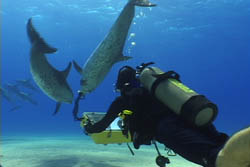by Hardy Jones
When I realized that our initial contacts with the spotted dolphins in the Bahamas were not a one-time event, it became clear there was an extraordinary opportunity to study a group of highly intelligent animals in the wild.
There was an obvious comparison between the work we were doing and the groundbreaking efforts of Dr. Jane Goodall at Gombe Stream Reserve in Tanzania. We had hoped to have her join us in the Bahamas but when that wasn’t possible my work on a PBS special in 1087 gave me the opportunity to visit her at her worksite on Lake Tanganyika.
The trip was not an easy one. Julia Whitty, Nat Katzman (a producer from PBS)) and I went through Nairobi on the way to Dar Es Salaam, Tanzania. We stayed at the legendary Norfolk Hotel, had magnificent breakfasts every morning and sortied out to various national parks to cover stories about people who were making a difference in the protection of wildlife in Kenya for our film “Saving the Wildlife”.
When we returned to the Norfolk one evening we found a letter under our door from Dr. Goodall asking us to bring a few things with us when we flew to meet her in Tanganyika. The request included motor parts, some T-shirts and hats. We wondered why she didn’t just get them in Dar Es Salaam but purchased and packed them for the flight.
After arrival in Dar Es Salaam we soon learned the reason for her request – the city had absolutely nothing available to buy. Nothing. No thing. The socialist regime of Julius Nyerere had absolutely ruined the economy. Small shops were open but had nothing to sell. When we sat down to breakfast there was a full menu. We ordered and the waiter dutifully noted our requests. And then nothing came. All we could get was tea and stale bread.
We flew in a twin-engine charter plane from Dar to Kigoma, on the eastern shore of Lake Tanganyika close to the border with Burundi. There we were met by a small skiff powered by a single outboard motor and operated by two young African men who did not speak English. The vessel, sent by Dr. Goodall, was covered by a wooden roof held up by four two-by-twos.
Dr. Goodall had advised us to buy our own food in Kigoma to bring to her home site. We went to the market but the fruits, vegetables and meat were so covered with flies that we defaulted to “well, she’s got to have something better than this.”
Lake Tanganyika is the longest fresh water lake in the world measuring 675 kilometres north to south and is 500 feet deep in some areas, making it the second deepest lake in the world. We motored along the shore for a couple of hours appalled by endless hillsides absolutely denuded of trees. In some places the hills were gouged by runoff and the soil showed bright rust in color. In other areas the slopes were great burnt swaths. It was sickening.
A southerly wind pushed up some fairly good swells that helped our ramshackle vessel along at a good clip. We were starting to relax when the motor quit a hundred yards off a small village. We started drifting toward shore. The conversation turned to the highly poisonous water cobras common in the lake and the danger of exposure to the parasite Schistosomiasis. We weren’t sure but we’d heard that the parasitic worms or flukes could enter the urethra and make their way to the bladder. None of us were going to enter the water.
After 45 minutes the boat washed ashore on a beach just south of the village. The two young African men informed us by signs that they would run back to Kigoma to get a replacement part.
As we sat down on the beach a group of drunken men carrying assault rifles approached us. The had come from the civil war in the Congo just across the lake.
To be continued.
Friday, August 5, 2011
Subscribe to:
Post Comments (Atom)


No comments:
Post a Comment